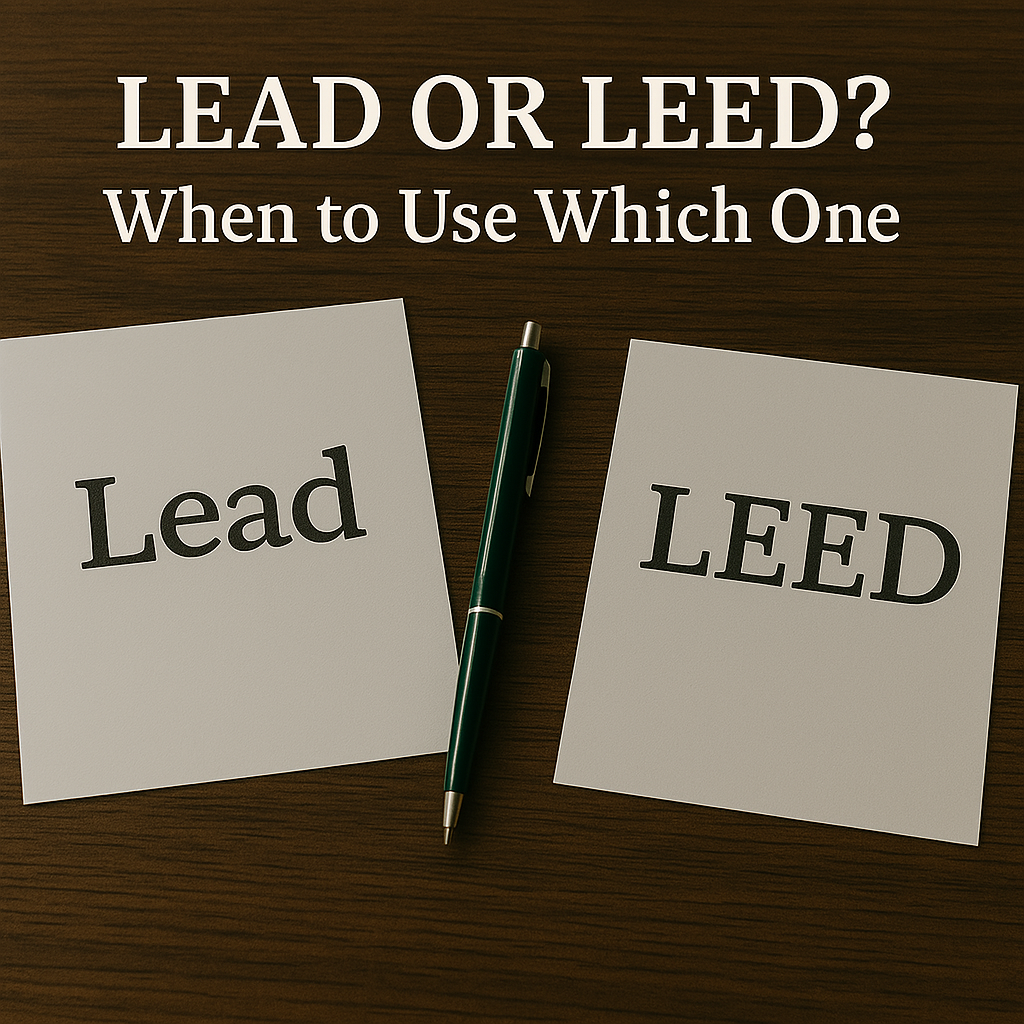Introduction
Infact many people confuse the words “Lead” and “LEED” because they sound the same. However, they have completely different meanings. Hence, Lead can refer to a metal, a leadership role, or business prospects, while LEED is a globally recognized certification for sustainable buildings.
However, using these words incorrectly can lead to misunderstandings, especially in industries like construction, business, and sustainability. This guide will break down the differences between “Lead” and “LEED,” their meanings, pronunciations, and correct usage.
Understanding “Lead”
Definition & Meaning
“Lead” is a word with multiple meanings, depending on its use in a sentence:
- As a noun:
- Lead (Metal): A heavy, toxic metal (symbol: Pb) used in batteries, pipes, and radiation shielding.
- Lead (Business/Sales): A potential customer or business opportunity.
- As a verb:
- To guide, direct, or be in charge of something (“She will lead the team to success.”).
- As an adjective:
- Used to indicate a main or principal role (“He is the lead actor in the movie.”).
- Read More About This Article: Connector or Connecter: The Correct Spelling and Usage Explained
Common Uses of “Lead”
| Context | Example Sentence |
|---|---|
| Metal | The old house has lead pipes, which need to be replaced. |
| Leadership | A good manager must lead by example. |
| Sales & Business | The company generated 500 new sales leads last month. |
Pronunciation Differences
- Lead (metal) → Pronounced “led” (rhymes with “red”).
- Lead (verb/noun for leadership) → Pronounced “leed” (rhymes with “reed”).
Mistaking the pronunciation can completely change the meaning of a sentence.
Understanding “LEED”
What is LEED?
The U.S. Green Building Council (USGBC) globally recognizes and awards LEED (Leadership in Energy and Environmental Design) certification for sustainable buildings. Developed by the U.S. Green Building Council (USGBC), LEED promotes energy-efficient, environmentally friendly construction.
Why LEED Matters
- Encourages sustainable building practices.
- Helps reduce energy consumption and carbon footprints.
- Increases property value and reduces maintenance costs.
- Recognized internationally as a standard for green buildings.
LEED Certification Levels
| LEED Level | Points Required |
|---|---|
| Certified | 40-49 points |
| Silver | 50-59 points |
| Gold | 60-79 points |
| Platinum | 80+ points |
Buildings earn points based on:
✅ Energy efficiency
✅ Water conservation
✅ Use of recycled materials
✅ Indoor environmental quality
✅ Sustainable urban planning
How to Earn LEED Certification
To obtain LEED certification, a project must:
- Register with USGBC and pay fees.
- Submit documentation proving compliance with sustainability standards.
- Undergo a review and receive a score.
- Achieve one of the four certification levels based on points earned.
Key Differences Between “Lead” and “LEED”
| Feature | Lead | LEED |
|---|---|---|
| Meaning | Can be a metal, a leadership role, or a sales term | A sustainability certification for buildings |
| Pronunciation | “Led” (metal) or “Leed” (leadership) | Always “Leed” |
| Usage | Chemistry, business, leadership, construction | Green building, sustainability, urban development |
| Industry | Mining, sales, management | Architecture, real estate, environmental design |
Common Mistakes & How to Avoid Them
Using “Lead” and “LEED” incorrectly can create confusion. Here are common errors and how to fix them:
❌ Wrong: The new office building is lead-certified for sustainability.
✅ Correct: The new office building is LEED-certified for sustainability.
❌ Wrong: Our pipes are made of LEED.
✅ Correct: Our pipes are made of lead.
Case Study: The Impact of LEED Certification
Empire State Building – LEED Gold Certified
The Empire State Building, originally constructed in 1931, underwent a $550 million sustainability retrofit and achieved LEED Gold Certification.
Key sustainability improvements:
- 38% energy reduction, saving $4.4 million annually.
- Water conservation measures reduced consumption by 28%.
- LED lighting and smart energy management improved efficiency.
Result:
- Lower operational costs.
- Reduced carbon footprint.
- Higher property value and appeal to eco-conscious tenants.
Furthermore, this demonstrates how LEED certification helps buildings save money while benefiting the environment.
Final Thoughts
Moreover, understanding the difference between “Lead” and “LEED” is crucial for clear communication, especially in construction, business, and sustainability.
- Use “Lead” when referring to metal, leadership, or sales opportunities.
- Use “LEED” when discussing sustainable buildings and certification.
If you work in real estate, construction, or urban planning, you can boost your credibility and improve your projects’ sustainability by earning LEED certification.
✅ Want to learn more? Check out USGBC’s official site for the latest LEED certification details!
